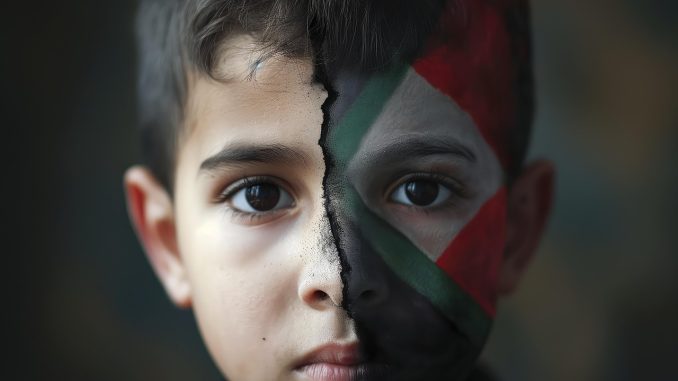
MOBILIZED NEWS FEATURE
“Divided We Fall: How Propaganda and Profit Turn People Against Each Other”
At Mobilized News, we are committed to exposing the machinery behind global manipulation and division. This isn’t just politics—it’s about power, profit, and the weaponization of perception. Across history and continents, from Nazi Germany to the MAGA movement to the current conflict in Gaza, propaganda has been used not just to mislead—but to fracture humanity and fuel war for the benefit of a powerful few.
Propaganda as a Weapon of War
Propaganda doesn’t merely misinform—it manufactures enemies. It simplifies reality into “good guys” and “bad guys,” creating a psychological battlefield where nuance dies and violence thrives. It’s no accident that during war, propaganda spikes. It’s not about truth; it’s about consent—manufactured, manipulated, and monetized.
Judaism ≠ Zionism: Faith Hijacked by Nationalism
One of the most dangerous tools of modern propaganda has been the conflation of Judaism, a millennia-old religion and cultural identity, with Zionism, a political ideology advocating for a Jewish ethnostate in historic Palestine.
Judaism is diverse, global, and rooted in spiritual tradition and ethical law. Many Jews around the world, including Orthodox, secular, and anti-colonial Jewish communities, do not identify with Zionism. In fact, countless Jewish scholars and rabbis have condemned the Israeli government’s treatment of Palestinians as contrary to Jewish ethics.
Zionism, on the other hand, is a modern nationalist project born in the late 19th century—its goals explicitly political. Since 1948, and especially since the occupation of the West Bank and Gaza, Zionism has been used to justify military aggression, systemic apartheid, and the ethnic cleansing of Palestinians.
To criticize Zionism is not to hate Jews. To say otherwise is propaganda. It’s a silencing tactic—used by governments and corporate media to delegitimize the global movement for Palestinian liberation.
Palestine ≠ Hamas: A People, Not a Party
Another deliberate distortion: equating Palestinians with Hamas. Palestinians are a people—diverse in religion, political beliefs, and geography—who have endured 75 years of displacement, occupation, and statelessness. They live under siege in Gaza, military occupation in the West Bank, apartheid laws in Israel, and exile across the world.
Hamas, on the other hand, is a political faction that rose to power in Gaza amid a vacuum of Palestinian leadership and failed peace negotiations. Its militancy is often highlighted in Western media without context: without discussion of decades of occupation, Israeli blockades, or the root causes of the conflict. While Hamas has committed acts that violate international law, the collective punishment of 2 million Palestinians in Gaza—half of them children—cannot be justified as “self-defense.”
To flatten the narrative—to say “Israel vs. Hamas”—is not journalism. It’s propaganda.
Middle East Crisis: A Real-Time Case Study in Propaganda
The war on Gaza is being livestreamed in real time, yet so is the misinformation. Western governments and media outlets continue to parrot Israeli military talking points, often uncritically. At the same time, Palestinian journalists, medics, and civilians are bombed, censored, and dehumanized.
Billions of dollars flow from U.S. taxpayers to Israeli weapons systems, while American media portray Palestinian suffering as collateral or inevitable. The actual motives—real estate, geopolitical dominance, arms sales—go unmentioned.
Corporations profit from war. Politicians win votes by appearing “tough on terror.” Media ratings spike with every airstrike. Meanwhile, the truth gets buried—often along with the bodies of innocents.
Same Playbook, Different Frontlines
What do all these examples—Nazism, authoritarian regimes, MAGA, and the Gaza war—have in common?
- Create a scapegoat.
- Simplify the story.
- Demonize dissent.
- Profit from chaos.
And above all: keep the people divided.
From Berlin to Brasília, from Michigan to Rafah, propaganda has one goal: protect the powerful, and keep the rest of us from realizing we have more in common with each other than with those who rule us.
Conclusion: Mobilize or Be Manipulated
If we’re ever going to build a just world, we must start by naming the lie: that war is peace, that critique is hate, that violence is defense.
Judaism is not Zionism. Palestine is not Hamas. America is not Trump. And we, the people, are not each other’s enemies.
It’s time to decolonize our minds, democratize our media, and organize across borders. The antidote to propaganda isn’t counter-propaganda—it’s truth, justice, and global solidarity.
Join the resistance to misinformation. Support independent journalism. Educate your community. Mobilize for peace and people, not profit and power.
Would you like this next as a downloadable PDF, social media post, or formatted article preview for your site?